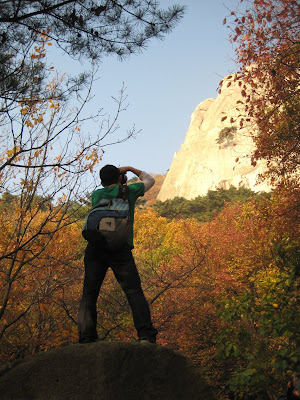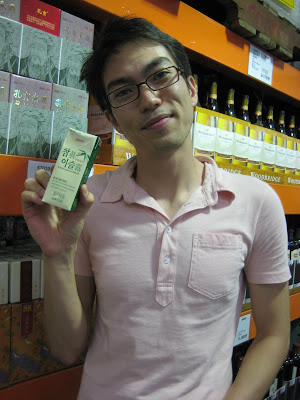
A few months ago my brother and I were having a discussion about Asian politics, particularly Korean and Japanese issues, since I live in Seoul and he's lived in Japan for nearly ten years. I made reference to
Dokdo (독 도), a group of rocky islets inhabited by just a handful of people in the waters between Korea and Japan. Ownership over the outcroppings has been heavily disputed for centuries. Josh had no idea what I was talking about when I said, "Dokdo." He said, "You mean 'Takeshima'?" Had another person been involved in the conversation, it could have become even more convoluted. Dokdo is also known as Takshima, the Liancourt Rocks, and the Hornet Islands, depending on who you're talking to. As the conversation progressed I realized we were each speaking about the controversial islets from the perspective of our resident countries. I used "Dokdo" and "East Sea", while Josh used "Takeshima" and "Sea of Japan". Furthermore, even as a foreigner with no stake in the issue, I found myself getting defensive of the Korean perspective, railing against Japanese imperialism and historic colonization.
This dispute between two rural Illinois siblings is ironically indicative of the larger picture. Korea claims absolute sovereignty over Dokdo, while Japan has repeatedly claimed over the years that Takeshima is Japanese territory. The controversy spikes every so often and most recently when Japan suggested it would claim territorial rights over the islets in upcoming school textbooks. Meanwhile, the United States didn't make things easier for Korea when its Board on Geographic Names categorized the islets as having "undesignated sovereignty". The BGN's designations are used as the U.S. federal government's standard. Although I found myself arguing like a Korean would with my brother, my outsider perspective actually tells me the BGN's classification makes perfect sense. Although it makes a thorny issue even more complex, the U.S. has been calling the islets the Liancourt Rocks since 1977 so as to stay out of the Korea-Japan dispute. Yet it officially recognized the islets as South Korean territory prior to the "undesignated sovereignty" debacle. So with Japan making refreshed claims to Dokdo at the same time the U.S. naming agency delivered a diplomatic slap in the face, it's no wonder Koreans were a little perturbed. Although the BGN name change was based on a decision made some time ago, the untimely release felt to Koreans like a U.S. vote in favor of Japan. Perhaps because this incident came on the heels of very spirited demonstrations against U.S. beef imports and amidst the Korea-U.S. Free Trade Agreement impasse, the Bush administration quickly instructed the BGN to re-designate the Liancourt Rocks as Korean territory on its website.
 "DO YOU KNOW? DOKDO BELONGS TO KOREA"
"DO YOU KNOW? DOKDO BELONGS TO KOREA"
Arguing back and forth with Japan, even through the highest diplomatic channels, seems to rarely bear substantial results for Korea. Several admonishments of Japan's claims by South Korean President Lee Myung-bak have done little to temper the issue. So when Korea's favorite phrase stating that Dokdo is "clearly Korean land historically, geographically, and by international law" (I can't count the number of times I've broadcast those exact words to an international audience) fell on deaf ears in Japan, Korea's strategy turned to convincing the rest of the world that Dokdo is, in fact, Korean territory. Nevermind that most people outside Korea have never even heard of Dokdo or care
who owns it. Regardless of what the islets are called on a map, they're barely even visible without a magnifying glass.
 "Dokdo Love"
"Dokdo Love"Of course the waters around Dokdo, and the sea life in them, are what's really at stake. Koreans seem unanimous in their belief that sovereignty over Dokdo is theirs, and the t-shirts with awkward claims in English point to the country's hope that the rest of the world can be convinced of the same.
 Here's a belated report from an early October trip to Andong, Gyeongsang Province, a few hours southeast of Seoul. The area is famous for traditional Korean cuisine eaten to honor ancestors (heotjesabap, similar to bibimbap), an old Confucian academy, and Andong's annual mask festival. Matt Kelley and I joined throngs of festival goers on an uncharacteristically hot October weekend. Here are some photos from the festival. For more information about North Gyeongsang Province, visit Matt's "Discovering Korea" website.
Here's a belated report from an early October trip to Andong, Gyeongsang Province, a few hours southeast of Seoul. The area is famous for traditional Korean cuisine eaten to honor ancestors (heotjesabap, similar to bibimbap), an old Confucian academy, and Andong's annual mask festival. Matt Kelley and I joined throngs of festival goers on an uncharacteristically hot October weekend. Here are some photos from the festival. For more information about North Gyeongsang Province, visit Matt's "Discovering Korea" website.


















































